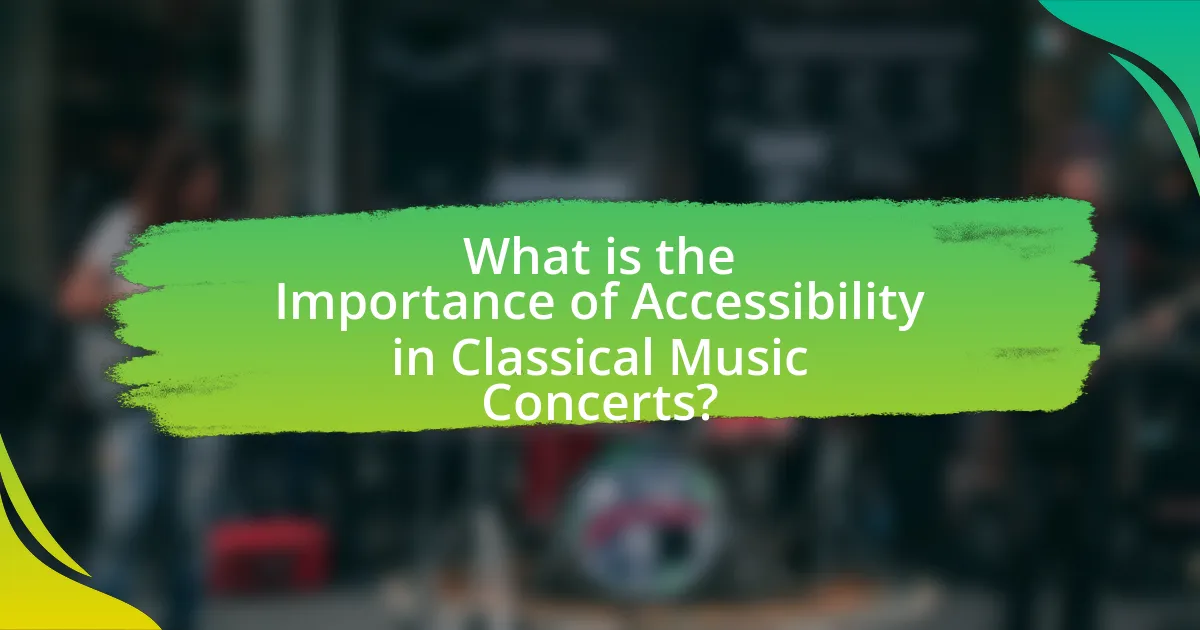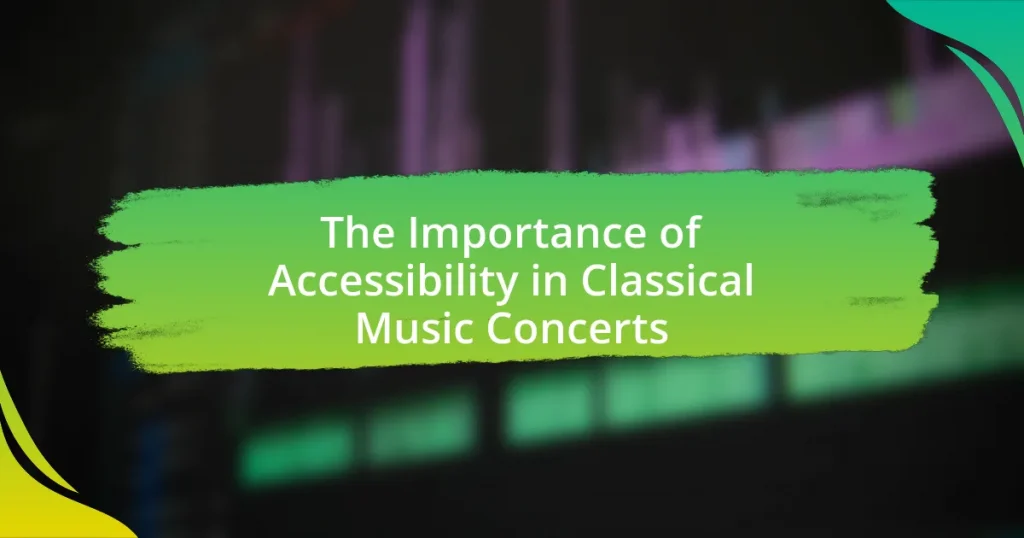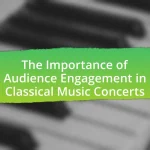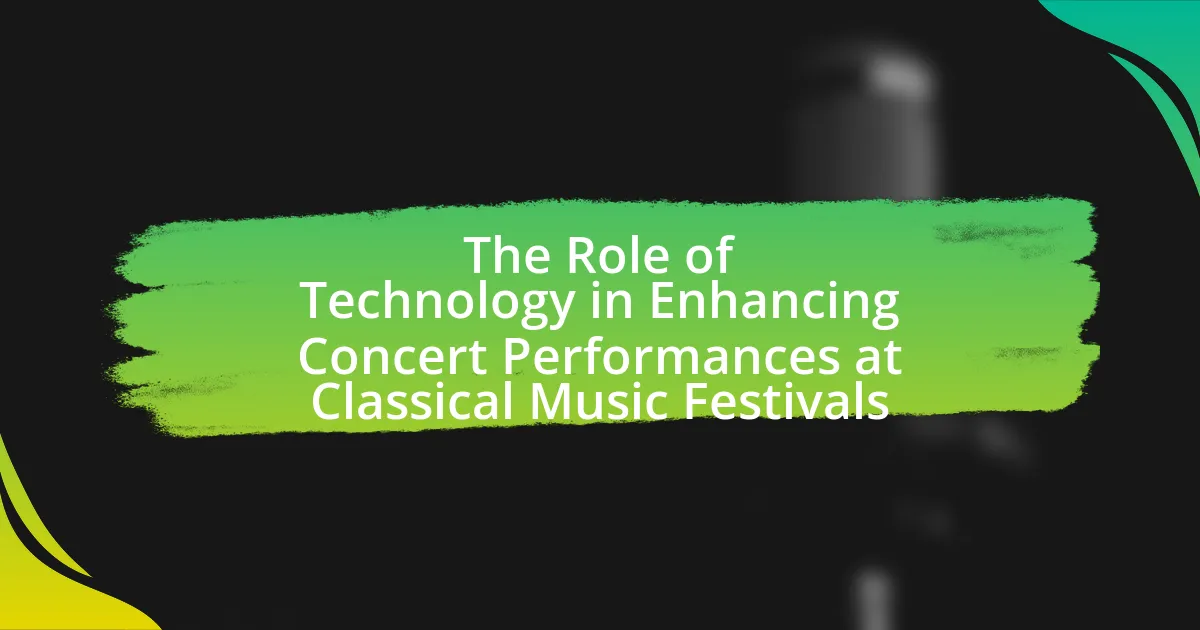Accessibility in classical music concerts is essential for ensuring that individuals with disabilities can fully engage with and enjoy performances. The article highlights the importance of inclusive practices, such as wheelchair access, sign language interpretation, and sensory-friendly environments, which not only comply with legal standards like the Americans with Disabilities Act but also enhance audience participation and satisfaction. It discusses the barriers faced by disabled individuals, the role of organizations and advocacy groups in promoting accessibility, and successful initiatives that have improved access to classical music. Additionally, the article outlines practical steps and best practices for concert organizers to create a more inclusive environment, ultimately enriching the cultural experience for all attendees.

What is the Importance of Accessibility in Classical Music Concerts?
Accessibility in classical music concerts is crucial as it ensures that individuals with disabilities can fully participate in and enjoy the experience. This inclusivity not only broadens the audience base but also enriches the cultural landscape by allowing diverse perspectives and experiences to be shared. According to the National Endowment for the Arts, accessible programming can increase attendance by up to 30%, demonstrating the tangible benefits of inclusivity. Furthermore, implementing features such as wheelchair access, sign language interpretation, and sensory-friendly environments aligns with legal requirements like the Americans with Disabilities Act, reinforcing the ethical obligation to provide equal access to cultural events.
Why is accessibility crucial for audiences in classical music?
Accessibility is crucial for audiences in classical music because it ensures that diverse groups, including those with disabilities, can experience and enjoy performances. By implementing features such as wheelchair access, sign language interpretation, and sensory-friendly environments, venues can accommodate individuals who might otherwise be excluded. Research indicates that approximately 15% of the global population lives with some form of disability, highlighting the need for inclusive practices in cultural settings. Furthermore, accessible programming can enhance audience engagement and broaden the listener base, ultimately enriching the classical music community.
What are the barriers faced by individuals with disabilities in attending concerts?
Individuals with disabilities face several barriers in attending concerts, including physical accessibility issues, lack of appropriate seating, inadequate transportation options, and insufficient accommodations for sensory sensitivities. Physical accessibility issues often arise from venues that do not comply with the Americans with Disabilities Act (ADA), which mandates accessible entrances, restrooms, and pathways. For instance, a study by the National Endowment for the Arts found that only 28% of surveyed venues provided adequate wheelchair-accessible seating. Additionally, many concert venues lack transportation services that cater to individuals with disabilities, making it difficult for them to reach the event. Furthermore, sensory sensitivities can be overlooked, as many concerts do not offer accommodations such as quiet areas or sensory-friendly performances, which are crucial for individuals with autism or other sensory processing disorders. These barriers collectively hinder the ability of individuals with disabilities to enjoy live music experiences fully.
How does accessibility enhance the concert experience for all attendees?
Accessibility enhances the concert experience for all attendees by ensuring that everyone, regardless of physical or cognitive abilities, can fully participate and enjoy the performance. Features such as wheelchair ramps, designated seating, and assistive listening devices allow individuals with disabilities to access the venue and engage with the music. According to a study by the National Endowment for the Arts, inclusive practices in arts organizations lead to increased attendance and satisfaction among diverse audiences, demonstrating that accessibility not only benefits those with disabilities but also enriches the overall concert atmosphere for all attendees.
What are the key components of accessibility in classical music concerts?
The key components of accessibility in classical music concerts include physical access, sensory accommodations, and inclusive programming. Physical access ensures that venues are equipped with ramps, elevators, and accessible seating to accommodate individuals with mobility challenges. Sensory accommodations involve providing assistive listening devices, sign language interpreters, and braille programs to support those with hearing or visual impairments. Inclusive programming focuses on creating diverse performances that reflect various cultural backgrounds and engaging audiences with different abilities, thereby fostering a welcoming environment for all attendees. These components are essential for ensuring that classical music concerts are accessible to a broader audience, promoting inclusivity and participation in the arts.
What physical accommodations should be provided at concert venues?
Concert venues should provide accessible seating, ramps, elevators, and restrooms to accommodate individuals with disabilities. Accessible seating ensures that people with mobility impairments can enjoy the performance alongside others, while ramps and elevators facilitate easy access to different levels of the venue. Additionally, accessible restrooms are essential for ensuring that all attendees can comfortably use the facilities. According to the Americans with Disabilities Act (ADA), these accommodations are not only recommended but required for public venues to ensure equal access for all individuals.
How can technology improve accessibility for classical music audiences?
Technology can improve accessibility for classical music audiences by providing tools such as live streaming, captioning, and mobile applications that enhance the concert experience. Live streaming allows individuals who cannot attend in person due to mobility issues or geographical constraints to enjoy performances from home. Captioning services offer real-time translations of lyrics and spoken content, making performances more inclusive for those with hearing impairments. Additionally, mobile applications can provide information about the concert, including program notes and artist backgrounds, which can be particularly beneficial for audiences with cognitive disabilities. These technological advancements have been shown to increase audience engagement and participation, as evidenced by a study from the National Endowment for the Arts, which found that accessible programming can lead to a 30% increase in attendance among diverse audiences.
What role do organizations play in promoting accessibility in classical music?
Organizations play a crucial role in promoting accessibility in classical music by implementing inclusive practices and providing resources that cater to diverse audiences. They develop programs that offer adaptive technologies, such as audio descriptions and sign language interpretation, ensuring that individuals with disabilities can fully engage with performances. For instance, the League of American Orchestras has initiated accessibility guidelines that encourage orchestras to create welcoming environments for all patrons. Additionally, organizations often collaborate with advocacy groups to raise awareness about accessibility issues, thereby fostering a culture of inclusivity within the classical music community.
How do advocacy groups influence accessibility policies in the arts?
Advocacy groups influence accessibility policies in the arts by actively campaigning for inclusive practices and legislation that ensure equal access for individuals with disabilities. These organizations often conduct research, gather data, and present compelling evidence to policymakers, demonstrating the need for improved accessibility measures. For instance, the Americans with Disabilities Act (ADA) was significantly shaped by advocacy efforts, which highlighted the barriers faced by disabled individuals in cultural spaces. By collaborating with artists, institutions, and government entities, advocacy groups help to create guidelines and standards that promote accessibility in arts programming, ensuring that all audiences can participate fully in cultural experiences.
What initiatives have been successful in increasing accessibility in classical music?
Successful initiatives in increasing accessibility in classical music include the implementation of sensory-friendly concerts, the provision of audio descriptions, and the establishment of community outreach programs. Sensory-friendly concerts, designed for individuals with sensory sensitivities, often feature adjusted sound levels and reduced lighting, making performances more comfortable. Audio descriptions enhance the experience for visually impaired audiences by providing real-time narration of visual elements during performances. Community outreach programs, such as free concerts in underserved areas and partnerships with schools, broaden access to classical music for diverse populations. These initiatives have been validated by studies showing increased attendance and engagement from previously underrepresented groups in classical music settings.
How can concert organizers implement better accessibility practices?
Concert organizers can implement better accessibility practices by ensuring venues are equipped with features such as wheelchair ramps, accessible seating, and assistive listening devices. These modifications allow individuals with disabilities to enjoy performances without barriers. According to the Americans with Disabilities Act (ADA), venues must provide equal access to all patrons, which includes physical access and accommodations for sensory impairments. Additionally, organizers can offer services like sign language interpretation and sensory-friendly performances, which cater to diverse audience needs. Implementing these practices not only complies with legal requirements but also enhances the overall concert experience for all attendees.
What are the challenges faced when improving accessibility in classical music concerts?
Improving accessibility in classical music concerts faces several challenges, including physical barriers, lack of awareness, and insufficient resources. Physical barriers such as inadequate seating arrangements and inaccessible venues hinder individuals with mobility impairments from attending. Additionally, a lack of awareness among organizers about the needs of diverse audiences can lead to insufficient accommodations, such as the absence of sign language interpreters or audio descriptions for those with hearing or visual impairments. Furthermore, limited financial resources often restrict the implementation of necessary accessibility features, making it difficult for organizations to prioritize these improvements. These challenges collectively impede the goal of making classical music concerts inclusive for all audiences.
How can funding and resources be allocated effectively for accessibility improvements?
Funding and resources can be allocated effectively for accessibility improvements by conducting thorough assessments of existing barriers and prioritizing projects based on impact and feasibility. Organizations should engage with individuals with disabilities to identify specific needs and preferences, ensuring that the allocated resources address the most pressing accessibility issues. For instance, a study by the National Endowment for the Arts found that targeted investments in accessible seating and assistive technologies significantly enhance the concert experience for individuals with disabilities. By leveraging data from such assessments and studies, funding can be directed towards initiatives that yield the highest benefit, thereby maximizing the effectiveness of resource allocation in improving accessibility in classical music concerts.
What best practices can be adopted for enhancing accessibility in classical music concerts?
To enhance accessibility in classical music concerts, venues should implement a range of best practices including providing wheelchair access, offering assistive listening devices, and ensuring clear signage. Wheelchair access allows individuals with mobility impairments to navigate the venue comfortably, while assistive listening devices, such as hearing loops, improve audio clarity for those with hearing loss. Clear signage, including braille and large print, aids visually impaired attendees in finding their way. According to the National Endowment for the Arts, accessible venues can increase attendance by up to 20%, demonstrating the positive impact of these practices on audience engagement.
How can feedback from audiences with disabilities shape accessibility initiatives?
Feedback from audiences with disabilities can significantly shape accessibility initiatives by providing direct insights into their specific needs and preferences. This feedback allows organizations to identify barriers that may not be apparent to those without disabilities, leading to more effective and tailored accessibility solutions. For instance, a study by the National Endowment for the Arts found that 70% of individuals with disabilities reported that accessibility features influenced their decision to attend cultural events. By incorporating this feedback, organizations can enhance their offerings, ensuring that venues, programs, and services are inclusive and welcoming, ultimately fostering greater participation in classical music concerts.
What are some examples of successful accessible concert programs?
Successful accessible concert programs include the “Open Doors” initiative by the New York Philharmonic, which offers sensory-friendly performances designed for individuals with autism and other sensory sensitivities. Another example is the “Accessible Concerts” program by the London Symphony Orchestra, which provides audio descriptions and sign language interpretation for deaf and hard-of-hearing audiences. Additionally, the Chicago Symphony Orchestra’s “Music Without Barriers” series features relaxed performances that accommodate various needs, including quiet spaces and flexible seating arrangements. These programs demonstrate a commitment to inclusivity and have received positive feedback from participants, highlighting their effectiveness in making classical music accessible to diverse audiences.
What practical steps can be taken to ensure accessibility in future classical music concerts?
To ensure accessibility in future classical music concerts, venues should implement features such as wheelchair ramps, designated seating areas, and assistive listening devices. These modifications allow individuals with mobility impairments to navigate the space comfortably and enjoy the performance. Additionally, providing clear signage and information in multiple formats, including braille and large print, enhances the experience for visually impaired attendees. Research indicates that approximately 15% of the global population lives with some form of disability, highlighting the necessity for inclusive practices in public events. By adopting these measures, concert organizers can create an environment that welcomes all audiences, thereby enriching the cultural experience for everyone.






